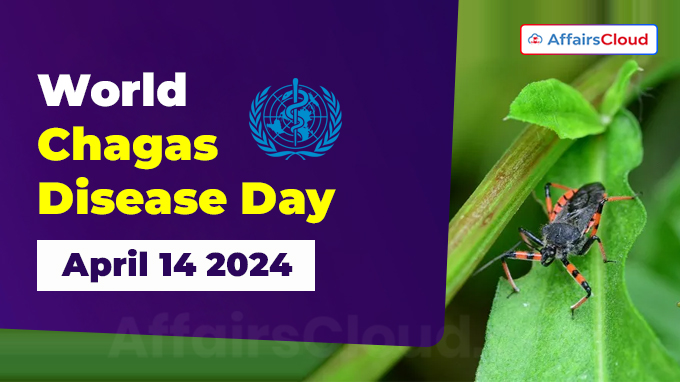 World Chagas Disease Day (WCDD) is annually observed across the globe on 14 April to raise awareness about Chagas Disease (also known as American trypanosomiasis), a neglected tropical disease (NTD) that can cause serious heart and digestive issues.
World Chagas Disease Day (WCDD) is annually observed across the globe on 14 April to raise awareness about Chagas Disease (also known as American trypanosomiasis), a neglected tropical disease (NTD) that can cause serious heart and digestive issues.
- WCDD also aims to improve early detection, expand diagnostic coverage, and provide equitable access to clinical care for Chagas Disease.
Theme:
The theme for WCDD 2024 is “Tackling Chagas Disease: Detect Early and Care for Life.”
- The theme focuses on increasing public awareness of Chagas disease, securing funding, supporting early diagnosis, and lifelong follow-up of people affected by the disease.
Background:
i.In 2019, the 72nd World Health Assembly declared the 14 April of every year as World Chagas Disease Day.
ii.The first-ever World Chagas Disease Day was observed on 14 April 2020.
Why April 14?
On 14 April 1909, a Brazilian physician and researcher Carlos Justiniano Ribeiro Chagas diagnosed the 1st human case of the disease in a 2-year-old child, Berenice Soares de Moura of Brazil.
- The disease is named after Carlos Justiniano Ribeiro Chagas.
Chagas Disease:
i.Chagas disease is an infectious and potentially life-threatening illness caused by the protozoan parasite Trypanosoma cruzi (T. cruzi). It is also known as a “silent or silenced disease” due to often mild or absent symptoms.
ii.Chagas disease, prevalent in continental Latin America, is increasingly detected globally.
iii.The World Health Organisation (WHO) recognised Chagas disease as an NTD in 2005.
Note: According to WHO, approximately 6-7 million people are infected with Chagas disease globally with about 12,000 deaths annually; and 30,000 to 40,000 new cases every year.
Transmission and Endemic Areas:
i.Chagas disease is found mainly in endemic areas of 21 continental Latin American countries.
ii.It has been primarily transmitted to humans by contact with feces or urine of triatomine bugs (vector-borne), known as ‘kissing bugs‘.
iii.It can also be transmitted orally (food-borne), during pregnancy or birth (congenital), through blood/blood products, organ transplantation, and laboratory accidents.
Challenges:
i.Chagas disease is curable if antiparasitic treatment is initiated early, in the acute phase.
ii.Chronic infection requires ongoing treatment and follow-up to prevent disease progression and transmission.
iii.Chronic Chagas disease can cause serious heart or digestive complications.
iv.Up to a third of people with chronic infection develop cardiac alterations and 1 in 10 develop digestive, neurological or mixed alterations
Preventive Strategies:
i.Vector control in Latin America.
ii.Blood screening before transfusion and transplantation.
iii.Testing and treating girls, women of reproductive age, newborns, and siblings of infected mothers.
iv.Information, education, and communication for communities and health professionals.
Medications for Treatment:
i.Benznidazole and Nifurtimox: Kill the parasite and are most effective in the acute phase.
ii.Efficacy diminishes with prolonged infection; Adverse reactions are more frequent in older age.
Treatment Considerations:
i.Not recommended for pregnant women or individuals with kidney/liver failure.
ii.Nifurtimox is contraindicated for those with neurological or psychiatric disorders.
About World Health Organisation (WHO):
Director General– Dr Tedros Adhanom Ghebreyesus
Headquarters– Geneva, Switzerland
Established on– 7 April 1948




